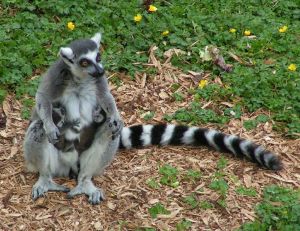Difference between revisions of "Prosimian" - New World Encyclopedia
Rick Swarts (talk | contribs) |
Rick Swarts (talk | contribs) |
||
| Line 28: | Line 28: | ||
**** Parvorder [[Platyrrhini]]: New World monkeys (4 families) | **** Parvorder [[Platyrrhini]]: New World monkeys (4 families) | ||
**** Parvorder [[Catarrhini]]: humans and other Old World primates (3 families) | **** Parvorder [[Catarrhini]]: humans and other Old World primates (3 families) | ||
| + | |||
| + | ==References== | ||
| + | Smithsonian National Zoological Park (SNZP). 2008. | ||
| + | http://nationalzoo.si.edu/Animals/Primates/Facts/Primateness/Differences/ | ||
| + | Great apes and other primates: Differences among prosimians, monkeys and apes | ||
| + | |||
[[Category:Life sciences]] | [[Category:Life sciences]] | ||
Revision as of 18:40, 29 August 2008
Prosimians are the most primitive extant primates; they have characteristics similar to forms that were ancestral to monkeys, apes and humans. Prosimians are the only primates native to Madagascar, and are also found in Southeast Asia. They include lemurs, the Aye-aye, bushbabies, and tarsiers. With the exception of the tarsiers, all of the prosimians are in the suborder Strepsirrhini. Due to this reason the classification is not phylogenetically 'valid', as they do not share a unique last common ancestor, and anatomical traits.
The adapids are an extinct grouping that were most certainly prosimians and closely related to the strepsirhines. The omomyids are another extinct group of prosimians but they are believed to be haplorrhines, closely related to the tarsiers, but an outgroup to the rest of the haplorrhines.
Classification
The prosimians were once considered a suborder of the Primate order (suborder Prosimii)(Gr. pro, before, + simia, ape). They have been shown, however, to be paraphyletic - that is, the smallest clade of related species that includes all of the prosimians also includes other species - in this case all of the primates.This relationship is shown by the ranks (prosimians in bold) in the list below of the current Primate classification between the order and family level. The classification is used on a more behavioural term nowadays, due to the lack of a unique last common ancestor.
- ORDER PRIMATES
- Suborder Strepsirrhini: non-tarsier prosimians
- Infraorder Lemuriformes
- Superfamily Cheirogaleoidea
- Family Cheirogaleidae: dwarf lemurs and mouse-lemurs
- Superfamily Lemuroidea
- Family Lemuridae: lemurs
- Family Lepilemuridae: sportive lemurs
- Family Indriidae: woolly lemurs and allies
- Superfamily Cheirogaleoidea
- Infraorder Chiromyiformes
- Family Daubentoniidae: Aye-aye
- Infraorder Lorisiformes
- Family Lorisidae: lorises, pottos and allies
- Family Galagidae: galagos
- Infraorder Lemuriformes
- Suborder Haplorrhini: tarsiers, monkeys and apes
- Infraorder Tarsiiformes
- Family Tarsiidae: tarsiers
- Infraorder Simiiformes
- Parvorder Platyrrhini: New World monkeys (4 families)
- Parvorder Catarrhini: humans and other Old World primates (3 families)
- Infraorder Tarsiiformes
- Suborder Strepsirrhini: non-tarsier prosimians
ReferencesISBN links support NWE through referral fees
Smithsonian National Zoological Park (SNZP). 2008. http://nationalzoo.si.edu/Animals/Primates/Facts/Primateness/Differences/ Great apes and other primates: Differences among prosimians, monkeys and apes
Credits
New World Encyclopedia writers and editors rewrote and completed the Wikipedia article in accordance with New World Encyclopedia standards. This article abides by terms of the Creative Commons CC-by-sa 3.0 License (CC-by-sa), which may be used and disseminated with proper attribution. Credit is due under the terms of this license that can reference both the New World Encyclopedia contributors and the selfless volunteer contributors of the Wikimedia Foundation. To cite this article click here for a list of acceptable citing formats.The history of earlier contributions by wikipedians is accessible to researchers here:
The history of this article since it was imported to New World Encyclopedia:
Note: Some restrictions may apply to use of individual images which are separately licensed.
